Microstructure and Mechanical Properties of 34CrNiMo6 Steel Repaired by Friction Stir Processing
Abstract
:1. Introduction
2. Experimental Procedures
3. Results and Discussion
3.1. Microstructure
3.2. Mechanical Properties
4. Conclusions
Author Contributions
Funding
Acknowledgments
Conflicts of Interest
References
- Gong, B.; Duan, X.W.; Liu, J.S.; Liu, J.J. A physically based constitutive model of As-forged 34CrNiMo6 steel and processing maps for hot working. Vacuum 2018, 155, 345–357. [Google Scholar] [CrossRef]
- Branco, R.; Costa, J.D.; Antunes, F.V. Low-cycle fatigue behaviour of 34CrNiMo6 high strength steel. Theor. Appl. Fract. Mech. 2012, 58, 28–34. [Google Scholar] [CrossRef]
- Kuduzović, A.; Poletti, M.C.; Sommitsch, C.; Domankova, M.; Mitsche, S.; Kienreich, R. Investigations into the delayed fracture susceptibility of 34CrNiMo6 steel, and the opportunities for its application in ultra-high-strength bolts and fasteners. Mater. Sci. Eng. A 2014, 590, 66–73. [Google Scholar] [CrossRef]
- Cavaliere, P.; Silvello, A. Crack Repair in Aerospace Aluminum Alloy Panels by Cold Spray. J. Therm. Spray Technol. 2017, 26, 1–10. [Google Scholar] [CrossRef]
- Ogawa, K.; Niki, T. Repairing of Degraded Hot Section Parts of Gas Turbines by Cold Spraying. Key Eng. Mater. 2009, 417–418, 545–548. [Google Scholar] [CrossRef]
- Nascimento, M.P.; Voorwald, H.J.C.; Filho, J.D.C.P. Effects of several TIG weld repairs on the axial fatigue strength of AISI 4130 aeronautical steel-welded joints. Fatigue Fract. Eng. Mater. Struct. 2012, 35, 191–204. [Google Scholar] [CrossRef]
- Huang, C.; Lin, X.; Yang, H.; Liu, F.; Huang, W. Microstructure and Tribological Properties of Laser Forming Repaired 34CrNiMo6 Steel. Materials 2018, 11, 1722. [Google Scholar] [CrossRef] [PubMed]
- Huang, C.; Lin, X.; Liu, F.; Yang, H.; Huang, W. High strength and ductility of 34CrNiMo6 steel produced by laser solid forming. J. Mater. Sci. Technol. 2019, 35, 377–387. [Google Scholar] [CrossRef]
- Yang, H.; Lin, X.; Wu, X.; Huang, C. Laser Solid Forming Repairing and Remanufacturing of High Strength Steel. Rare Met. Mater. Eng. 2011, 40, 148–151. (In Chinese) [Google Scholar]
- Ahmad, Z.; Shahid, M.; Abbas, M. Effect of multiple repair welding on mechanical performance and corrosion resistance of quenched and tempered 30CrMnSiA steel. J. Braz. Soc. Mech. Sci. Eng. 2016, 39, 1–11. [Google Scholar] [CrossRef]
- Sun, S.D.; Liu, Q.; Brandt, M.; Luzin, V.; Cottam, R.; Janardhana, M.; Clark, G. Effect of laser clad repair on the fatigue behaviour of ultra-high strength AISI 4340 steel. Mater. Sci. Eng. A 2014, 606, 46–57. [Google Scholar] [CrossRef]
- Moreira, P.M.G.P.; Santos, T.; Tavares, S.M.O.; Richter-Trummer, V.; Vilaça, P.; Castro, P.M.S.T.D. Mechanical and metallurgical characterization of friction stir welding joints of AA6061-T6 with AA6082-T6. Mater. Des. 2009, 30, 180–187. [Google Scholar] [CrossRef]
- Thomas, W.M.; Nicholas, E.D.; Needham, J.C.; Murch, M.G.; Templesmith, P.; Dawes, C.J. Friction STIR Welding, International Patent Application. U.S. Patent US5460317A, 8 December 1991. [Google Scholar]
- Nandan, R.; Debroy, T.; Bhadeshia, H.K.D.H. Recent advances in friction-stir welding—Process, weldment structure and properties. Progr. Mater. Sci. 2008, 53, 980–1023. [Google Scholar] [CrossRef]
- Scialpi, A.; Filippis, L.A.C.D.; Cavaliere, P. Influence of shoulder geometry on microstructure and mechanical properties of friction stir welded 6082 aluminium alloy. Mater. Des. 2007, 28, 1124–1129. [Google Scholar] [CrossRef]
- Young, J.; Field, D.; Nelson, T. Material Flow during Friction Stir Welding of HSLA 65 Steel. Metall. Mater. Trans. A 2013, 44, 3167–3175. [Google Scholar] [CrossRef]
- Barnes, S.J.; Bhatti, A.R.; Steuwer, A.; Johnson, R.; Altenkirch, J.; Withers, P.J. Friction Stir Welding in HSLA-65 Steel: Part I. Influence of Weld Speed and Tool Material on Microstructural Development. Metall. Mater. Trans. A 2012, 43, 2342–2355. [Google Scholar] [CrossRef]
- Tamadon, A.; Pons, D.; Sued, K.; Clucas, D. Thermomechanical Grain Refinement in AA6082-T6 Thin Plates under Bobbin Friction Stir Welding. Metals 2018, 8, 375. [Google Scholar] [CrossRef]
- Ueji, R.; Fujii, H.; Cui, L.; Nishioka, A.; Kunishige, K.; Nogi, K. Friction stir welding of ultrafine grained plain low-carbon steel formed by the martensite process. Mater. Sci. Eng. A 2006, 423, 324–330. [Google Scholar] [CrossRef]
- Bate, P.S.; Hutchinson, W.B. Grain boundary area and deformation. Scr. Mater. 2005, 52, 199–203. [Google Scholar] [CrossRef]
- Reynolds, A.P.; Tang, W.; Posada, M.; Deloach, J. Friction stir welding of DH36 steel. Sci. Technol. Weld. Join. 2003, 8, 455–460. [Google Scholar] [CrossRef]
- Huang, C.; Lin, X.; Liu, F.; Cao, J.; Liu, F.; Huang, W. Effects of cooling condition on microstructure and mechanical properties in laser rapid forming of 34CrNiMo6 thin-wall component. Int. J. Adv. Manuf. Technol. 2016, 82, 1269–1279. [Google Scholar]
- Lee, W.S.; Su, T.T. Mechanical properties and microstructural features of AISI 4340 high-strength alloy steel under quenched and tempered conditions. J. Mater. Process. Technol. 1999, 87, 198–206. [Google Scholar] [CrossRef]

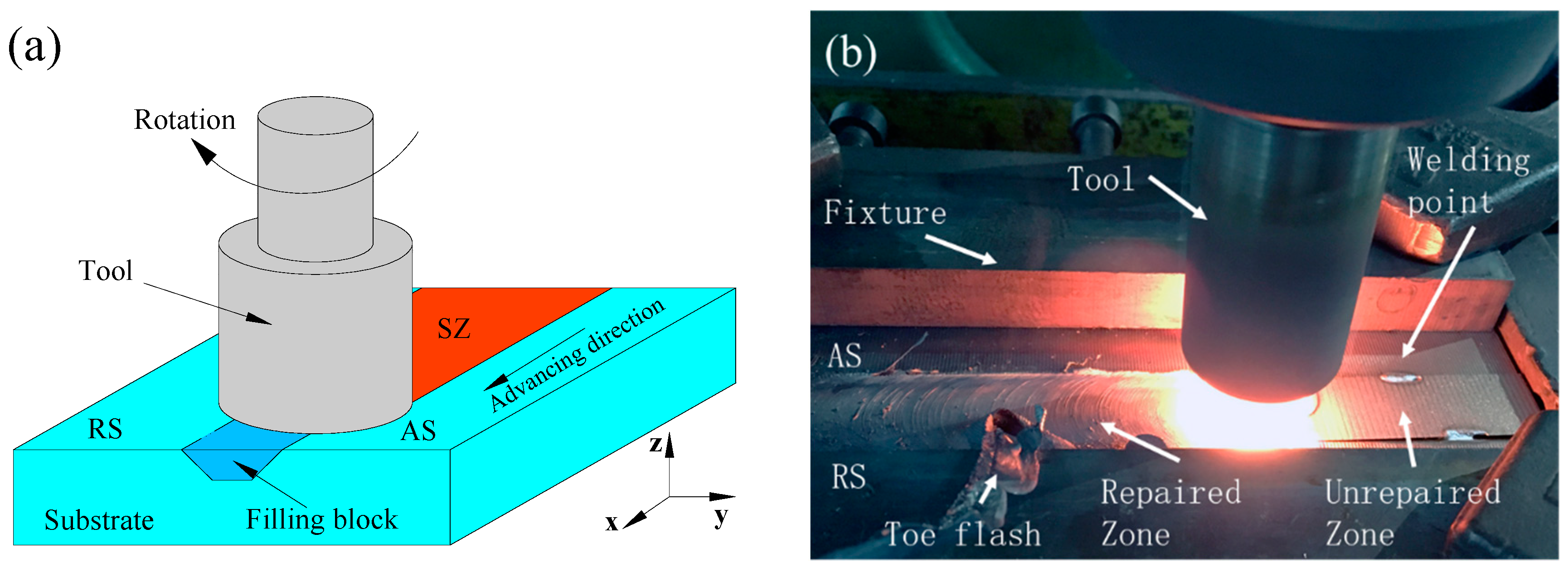




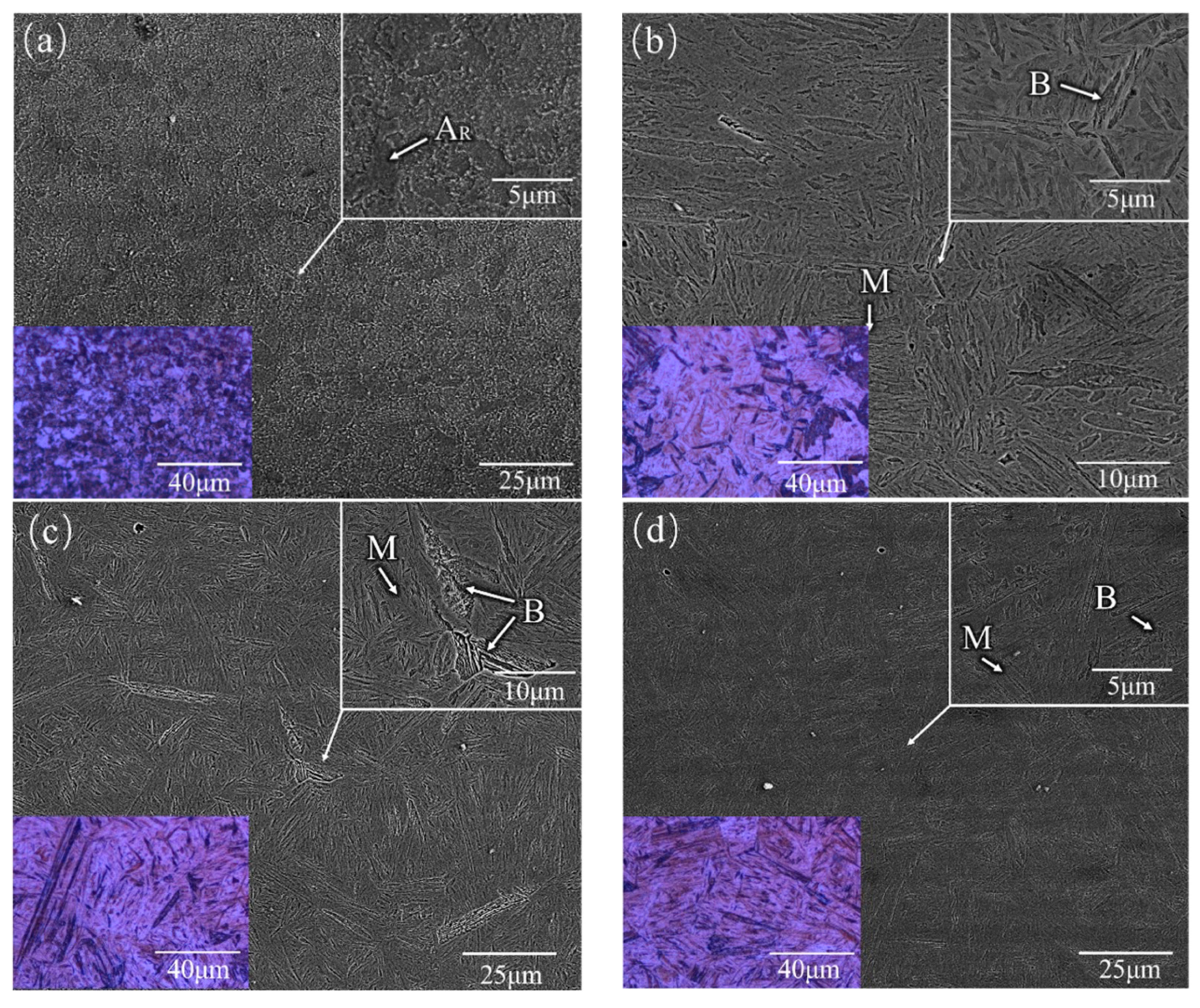
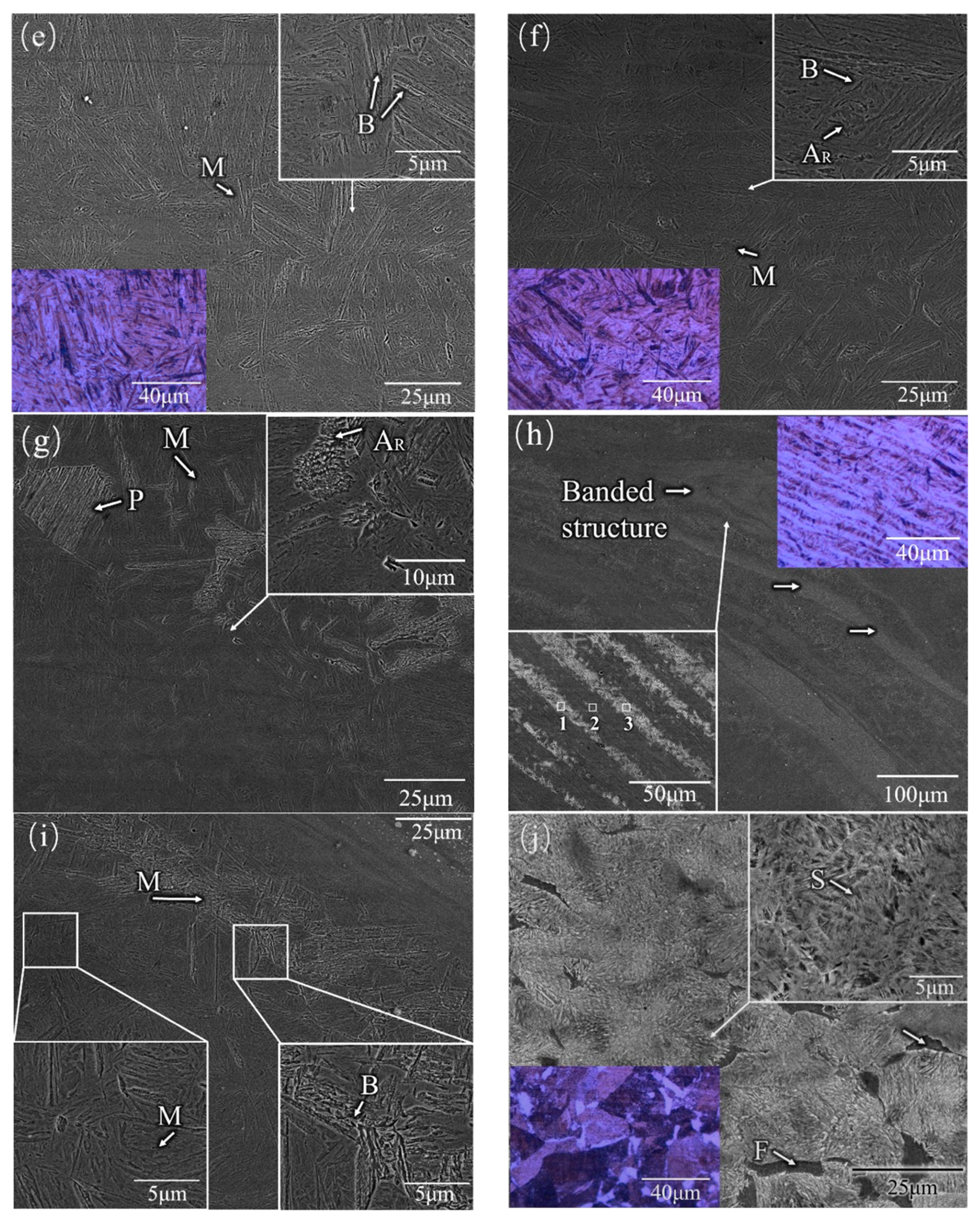

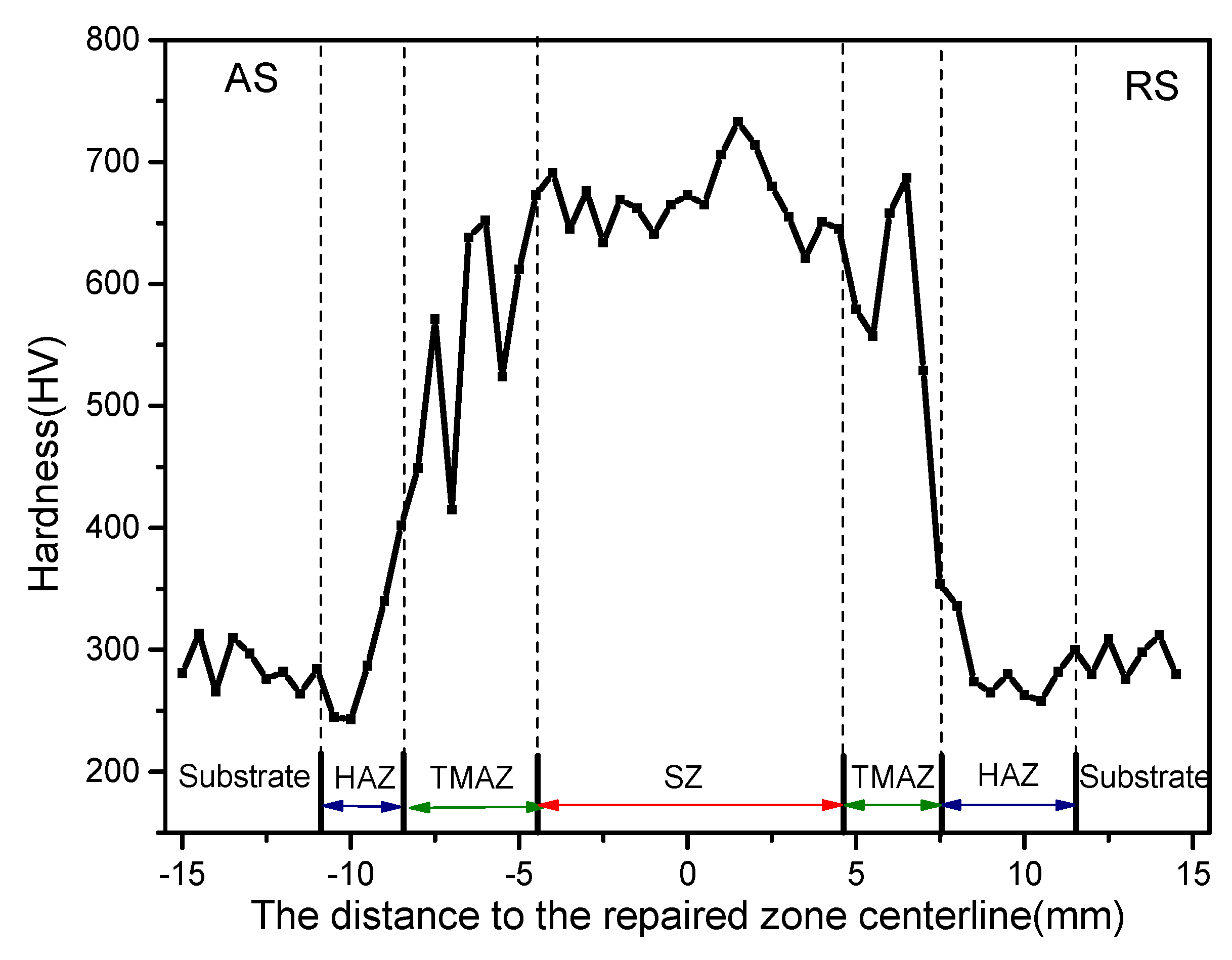
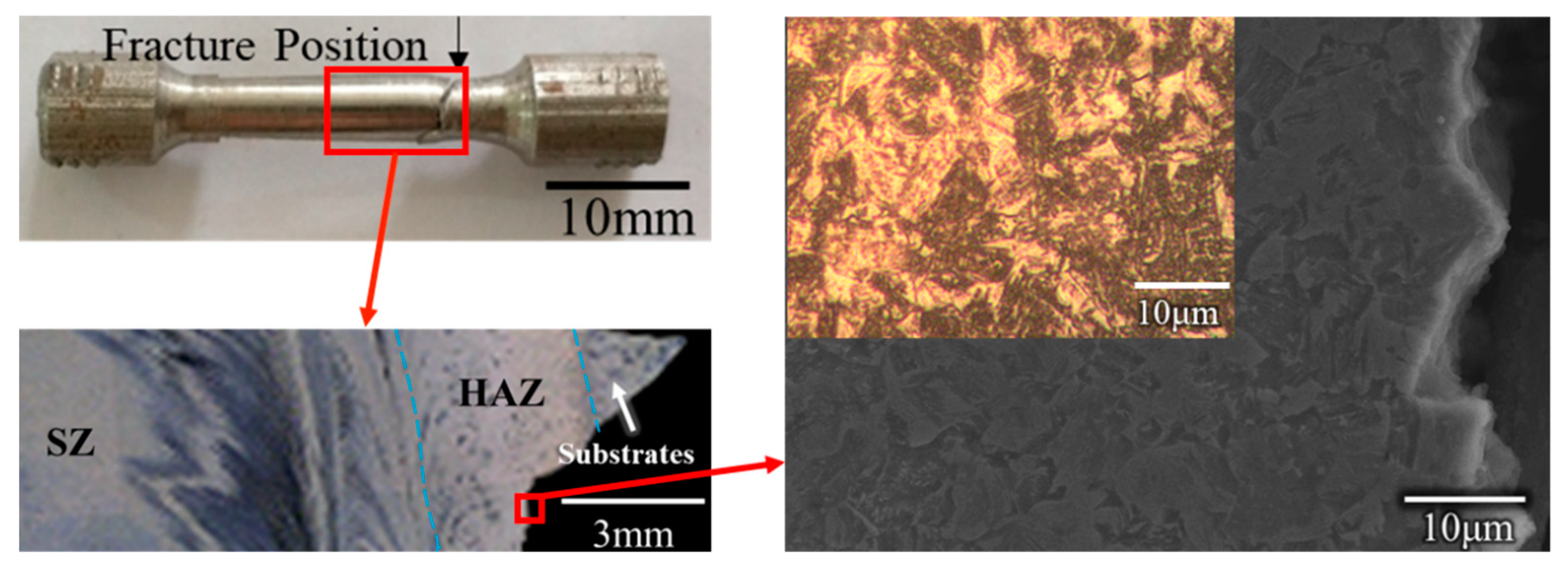

| Element | C | Cr | Ni | Mo | Mn | Si | Fe |
|---|---|---|---|---|---|---|---|
| Content | 0.34 | 1.5 | 1.5 | 0.25 | 0.50 | 0.40 | Balance |
| Rotation Speed (rpm) | Traverse Speed (mm/min) | Tilt Angle (°) | Argon Gas Rates (L/min) |
|---|---|---|---|
| 600 | 47.5 | 3 | 20 |
| Element | Fe | Cr |
|---|---|---|
| Region 1 | 98.64 | 1.36 |
| Region 2 | 98.84 | 1.16 |
| Region 3 | 98.74 | 1.26 |
| Sample | UTS (MPa) | Fracture Position |
|---|---|---|
| 1 | 860 | HAZ |
| 2 | 900 | HAZ |
| 3 | 890 | HAZ |
© 2019 by the authors. Licensee MDPI, Basel, Switzerland. This article is an open access article distributed under the terms and conditions of the Creative Commons Attribution (CC BY) license (http://creativecommons.org/licenses/by/4.0/).
Share and Cite
Wu, Z.; Huang, C.; Liu, F.; Xia, C.; Ke, L. Microstructure and Mechanical Properties of 34CrNiMo6 Steel Repaired by Friction Stir Processing. Materials 2019, 12, 279. https://doi.org/10.3390/ma12020279
Wu Z, Huang C, Liu F, Xia C, Ke L. Microstructure and Mechanical Properties of 34CrNiMo6 Steel Repaired by Friction Stir Processing. Materials. 2019; 12(2):279. https://doi.org/10.3390/ma12020279
Chicago/Turabian StyleWu, Zhongwen, Chunping Huang, Fencheng Liu, Chun Xia, and Liming Ke. 2019. "Microstructure and Mechanical Properties of 34CrNiMo6 Steel Repaired by Friction Stir Processing" Materials 12, no. 2: 279. https://doi.org/10.3390/ma12020279





